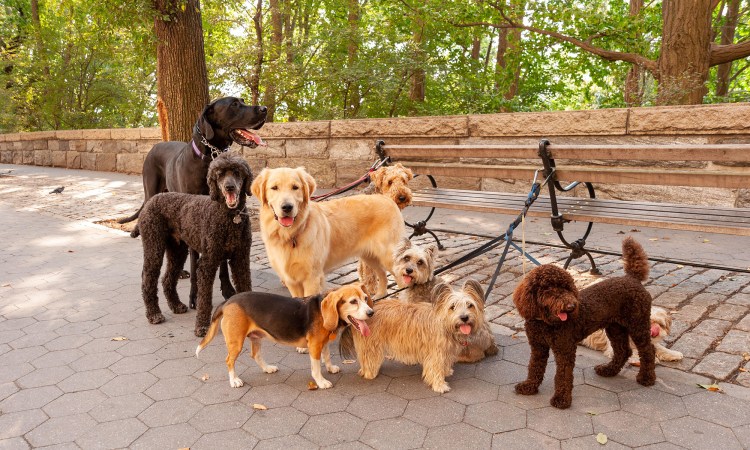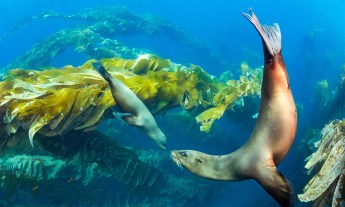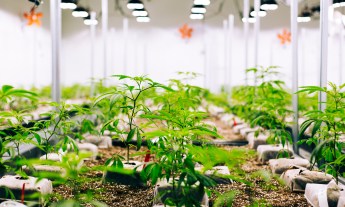
We all know the numbers by now. Industrial meat production is the single biggest cause of global deforestation.
It creates an estimated 14.5 percent of all human-made greenhouse gas emissions — more than the combined emissions from all forms of transport. In the face of these alarming numbers, there has been a groundswell of people attempting to eat zero, or less, meat.
But what about the little carnivores that share our homes, our beloved pets?
In the US alone, at least 70 percent of households own pets, according to the 2020-2021 APPA National Pet Owners Survey, and many of them are dogs. There are an estimated 77 million individual dogs in America — the highest number since the American Veterinary Medical Association began counting in 1982. Worldwide, more than 470 million dogs live with human families.
But as the food packaging and poop baggies pile up, some owners have begun to wonder about the impact their furry friend is having on the planet. What do we know about dogs’ environmental paw print, and are there things we can do to mitigate it?
America’s dogs and cats snarf down more than 200 petajoules worth of food per year — roughly the same as the entire human population of France.
Far and away the biggest environmental impact our canine companions exert is through their diet. The global pet food market was worth almost $97 billion in 2020. More than one-third of that food was purchased in the US, with other large markets in the UK, France, Brazil, Russia, Germany and Japan.
US dogs and cats snarf down more than 200 petajoules (a unit that measures the energy content of food) worth of food per year — roughly the same as the human population of France, according to Gregory Okin, a researcher at UCLA’s Institute of the Environment and Sustainability. “We’re talking about animals whose consumption is on the order of nations,” he says.
For the typical American dog, about 33 percent of those calories come from meat. According to Okin’s calculations, dogs and cats eat about one-quarter of all the meat-derived calories consumed in the US — which means their diets account for one-quarter of all the land, water, fossil fuel, fertilizer and pesticide use associated with producing that meat.
The result: An additional 64 million tons of greenhouse gases are being pumped into the atmosphere each year. That’s equivalent to 13.6 million cars being driven for a year.
Keep in mind, too that Okin’s numbers only reflect the environmental impacts of producing animals for meat. They don’t include the energy costs of transporting, slaughtering or processing those animals to become food. “And the processing with pet food is intense,” he says. Meat and meat by-products are typically heat-sterilized, extruded or rendered before being packaged, put on a truck and shipped around the country. All of which means that Okin’s numbers represent just a portion of the problem.
In the US most dog and cat poop ends up in a landfill, and by mass it rivals the total trash generated by the state of Massachusetts.
Of course, what goes in must come out. US dogs and cats produce as much feces as 90 million American adults, Okin found. Most of that ends up in landfill, and by mass it rivals the total trash generated by the state of Massachusetts. No-one has even attempted to calculate the carbon cost of transporting it all there.
Dog poop contains pathogens including bacteria, viruses and parasites that can transmit disease to people and persist in the soil for years. It also contains nitrogen and phosphorus — nutrients which, when they’re washed into nearby lakes and streams during storms, can fuel an explosion of algae. The growing algae deplete the water of vital oxygen, causing fish and other aquatic life to suffocate and die.
If you’re a responsible owner who picks up after your pooch, you probably plow through hundreds of petroleum-based plastic baggies — at least 700 per year if your dog “does her business” twice per day.
Then there’s the plastic waste. If you’re a responsible owner who dutifully picks up after your pooch, you may feel conflicted as you plow through hundreds of petroleum-based plastic baggies — at least 700 per year if your dog “does her business” twice per day. Even the “biodegradable” alternatives aren’t all they’re cracked up to be. That’s because they’re designed to break down under specific compost conditions, not in a landfill. But composting dog waste in your backyard is tricky and risky, and most municipal facilities do not accept pet waste. It’s a crappy predicament, all told.
And while food and feces are two immutable facts of dog ownership, all the little extras add up too. Toys are important to dogs’ mental and physical health, but many are made of plastic or contain elements that are difficult to recycle — and their durability is often poor.
Pet parents of all stripes spent almost one-third as much again on discretionary treats as they did on regular food in 2020. At least half of US owners bought Christmas and birthday gifts for their dogs in the past year. And then there are the outfits: More than 40 percent of dog owners admit to buying clothing or costumes for their dogs. All this discretionary stuff must be produced, packaged, shipped and, in many cases, delivered to our doors.
Are there more planet-friendly options?
Our relationships with our pets enrich our lives on so many levels. So, what is an environmentally-conscious dog lover to do?!
First and foremost, says Okin: Buy cheaper food with a lower overall meat content. “A lot of the marketing is like: ‘Your dog is a wolf, and he needs to eat like a wolf!’,” he says, citing recent consumer trends towards premium foods built from human-grade cuts of meat. “He is not a wolf. His ancestors were wolves, but your dog is a dog,” he says, adding, “Dogs have been evolving with us for 15,000 years, to the point where their dietary needs are actually very similar to our own.”
Make smaller tweaks such as being careful not to overfeed your dog and choose foods based on chicken or sustainably sourced fish instead of more environmentally taxing beef or lamb.
Notably, dogs are better able to digest starches, an ability thought to be tied to three key genes: AMY2B, MGAM and SGLT1. While wolves, coyotes and jackals typically have just two copies of AMY2B, domestic dogs tend to have at least five times that — some with as many as 22 copies.
In fact, while cats are considered “obligate carnivores” — meaning that their diet requires nutrients found only in animal flesh — modern dogs are such omnivores that plant-based foods, including non-meat protein sources such as yeast, insects and (soon!) lab-grown protein, are realistic and healthy alternatives. (In fact, major pet food companies are already developing insect-based dog and cat foods.) Talk to your vet about how much protein your particular dog needs and go from there.
If you’re not ready to make the leap to vegan, you can make smaller tweaks such as being careful not to overfeed your dog and choose foods based on chicken or sustainably sourced fish instead of more environmentally taxing beef or lamb.
At the very minimum, says Okin, leave the human-grade cuts for humans. Advertisers have persuaded us to be leery of budget brands made of “meat by-products,” suggesting these are poor-quality fillers that humans wouldn’t eat, so why give them to our dogs? “Most of the time, they’re confusing ‘wouldn’t’ with ‘couldn’t’,” Okin explains. A by-product is, after all, a culturally-defined concept — something that doesn’t make it to supermarket shelves. But meat by-products’ nutritional value remains high, and your dog will not know the difference.
Cut out waste
Your next priority should be to eliminate non-essential purchases. Your dog feels like part of the family, and it’s only natural you want to spoil him. But remember, he has no idea if it’s Halloween or Tuesday, and there are plenty of ways to express your love that don’t involve gifts. Chances are, nothing would make him happier than a trip to the shore or mountains or an indulgent extra 10 minutes at the dog park with his pals.
If your dog gets bored of new toys quickly, set up an exchange with other owners. Pick toys made of durable, natural materials such as sisal rope, or get creative and make your own out of household items or clothing that is beyond repair. You can even have a go at making dog treats yourself.
There are plenty of choices we can make, both small and large, to limit our doggos’ environmental impact while helping them and the planet to thrive.
Planet-conscious buying behaviors that apply to other aspects of your life will work here too: Buy local so that you can pick up supplies yourself, on foot. If you need to order for delivery, buy in bulk to reduce packaging and delivery frequency.
Finally, if you’re thinking of getting your first dog — or you are “between dogs,” as Okin puts it — consider a small breed. “Instead of a 40-pound dog, get a 10-pound dog,” he says, because smaller dogs both consume less and produce less waste. “Or instead of a 10-pound dog, get a parrot. Dogs and cats are not the only intelligent, long-living companion animals.”
Ultimately, being a good planetary steward does not mean forgoing our dogs, Okin stresses. There are plenty of choices we can make, both small and large, to limit our doggos’ environmental impact while helping both them and the planet to thrive.
So how did one of our oldest rivals, the wolf, evolve into man’s best friend? Discover the history of humanity’s first domesticated animal in this TED-Ed lesson:

















